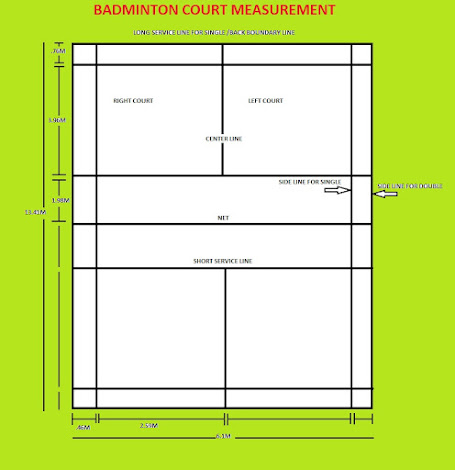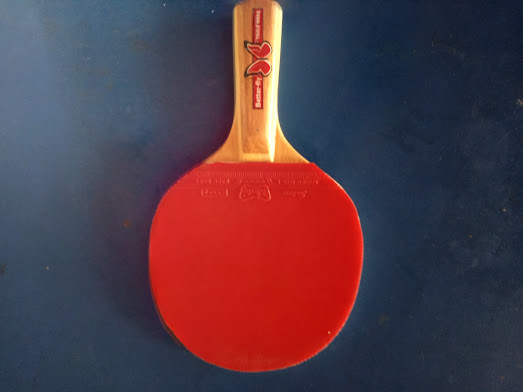Badminton court is in rectangular shape It is divided into two halves measuring 6.7m each and it is separated by badminton net that stand height is 1.55m at the ends and dips to 1.52m in the middle . court total length is 13.41M and Width is 6.1M . The two playing areas of either side in vertically divided down the middle after net the first line is short service line and distance between them is 1.98M . Then Next line is doubles long service line and distance between short service line and doubles long service line is 3.96M then next line or base line it is long service line for singles and distance between them is .76M .
Now width is also divided into two half one is right court and another is left court and two side line it's called Alley , It is like lobby in Kabbadi But here work is different . First side line for singles and second side line for doubles court because court side is same for both but for single alley is not a playing area , Alley width is.46M .
Badminton Net
Size of Net is 20ft long and 2.5ft height in meter 6mX0.8M
In Net small mesh are there mesh size is 19 mm and the Headband thickness is 37 mm
Basic Rules and Regulations of Badminton
If we play any game without knowledge of rule and regulations after some time game is like boring and we go for another game or without knowledge we play mean we loose the game and our interest is over that's why first we learn the rules.
So today we talk about badminton it is very interesting games, By learning the badminton rules and regulations, you will increase your understanding and enjoyment of the game. It plays in two forms Single or Doubles or tournament or just for recreation . Now you learn about the badminton rules and regulations will allow you to play better and enjoy the game more.
The rules of badminton games seem quite complicated at first with the variations between who will serve, the positioning on the court, and which areas of the court are considered in or out.
The Basics
Whether you are playing Singles or Doubles, these basics apply:
Required equipment for playing badminton
1. Badminton Racket 2. Shuttlecock 3. Rubber shoes 4. Light clothing 5. Water
Toss :In Badminton Toss is also a unique style , why unique because they use shuttlecock for toss But they also use coin in International matches ,this is done by hitting the shuttlecock upwards and the Narrow part or rubber cork of shuttlecock points to when it lands will the winner decide court or service . Those who win the toss he/she decide first he/she want court or serve If he want court means opponent start serve . If toss winner decide service means the opponent decide court .
First service must Serve from right side of the court then remaining serve is depend upon points .
Serve is Done according to score –whenever the score is even (0,2,4,6,…), the server must serve from the right side of the court, and when the score is odd (1,3,5…), the server must serve from the left side of the court. This is the criteria you will see in matches teammates switch positions on the court when the score changes.
always serve diagonally or opposite side. Means you start from your right court then you send shuttlecock to opponent right side court , if by mistake it not reach right side court means its fault and points given to opponent ,
If your rally is continues as long an and after some time shuttle does not go over the net or lands in same side or out side its called fault , if you touch your racket to top of the net, your body part , and your leg is cross the net line its all are fault .
Badminton Scoring Rules
The scoring system varies depending upon set means, if match consist 3 set so those who win best two set out of these three games wins. The same rules of scoring apply for both singles and doubles:
Each game is a race to 21 points.
A team scores anytime the opposite team has a fault, regardless of who serves.
Each time a team wins a rally, they earn one point.
If the score is tied at 20-20, the first team to gain a 2-point lead (ex. 23-21) upto 29 point after 29 those who take single point will win the game its called golden score .
Badminton Singles Rules (1 vs.1)
Start the game, By toss one player must toss the shuttlecock or coin. The side it points to will be the first to serve or decide court. Then both players will stand on the right side of their respective courts.
When serving, the server shuttlecock diagonally to the right side where their opponent is standing. If the shuttle lands in the opposite court or below the short service line it's called the wrong court and called short the other player scores a point. If the shuttlecock falls out of right court or cross the sideline for singles, then it is called out and the other team scores a point. After the serve, the two players can make the ball land anywhere within the playing portion of the court.
When the serving player scores, that player switches sides according to score is even or odd . If point is even, Player moves to the right side; if point is odd ,player moves to the left. The opponent player must change their side depending on where the serving player is. When the non-serving player scores, he/ she gets to next serve . Player will serve from the left (odd) or right (even) side of the court depending on his/her score.
Badminton Doubles Rules (2 vs. 2)
In Badminton Doubles court size is increase according to singles. Starting is same as Singles .
Mostly rules of Badminton Doubles are same only in service rule little bit change. You know first serve is start from right court and opponent also take shuttle in right court, those who start the serve and same team win a rally and get 1 point. so the same player do the serve but change the side why , because the point is odd so player serve form left court and opponent also receive shuttle to left court . Now this time opponent win the rally means score is 1-1 then now service turn for opponent team but the point is odd they start serve from left side of court ,and according to serve change your partner also change the position. then next rally win the opponent means score is 1-2 then the with serve player also change means first rally done by player A and same team wins rally continuously mean same player do the serve after change the court side but in between opponent take a point and again you win after point now server change to Player B .
In Badminton those who win best of two out of three will win the match .
Three set of 21 points , after 11 point break for 1 minute for making a strategy
After Every set both team change the court
If both team win 1-1 set. Now in final set after 11th point again both team change the court it is compulsory .
Badminton rules and regulations are many, why which is important because to learn as much as possible about the game. Whether you are playing it as a hobby or as a professional, you will find that the rules are an important feature of the game that you need to know to play it correctly and competitively.































